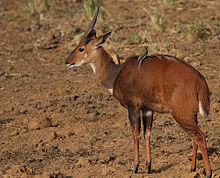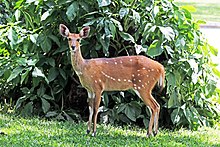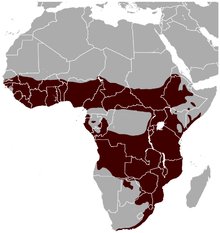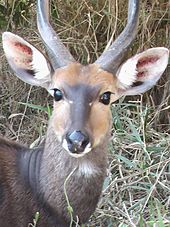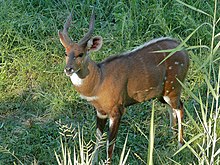
The bongo is a large, mostly nocturnal, forest-dwelling antelope, native to sub-Saharan Africa. Bongos are characterised by a striking reddish-brown coat, black and white markings, white-yellow stripes, and long slightly spiralled horns. It is the only tragelaphid in which both sexes have horns. Bongos have a complex social interaction and are found in African dense forest mosaics. They are the third-largest antelope in the world.

Bovines comprise a diverse group of 10 genera of medium to large-sized ungulates, including cattle, bison, African buffalo, water buffalos, and the four-horned and spiral-horned antelopes. The evolutionary relationship between the members of the group is still debated, and their classification into loose tribes rather than formal subgroups reflects this uncertainty. General characteristics include cloven hooves and usually at least one of the sexes of a species having true horns. The largest extant bovine is the gaur.

The lowland nyala or simply nyala is a spiral-horned antelope native to southern Africa. It is a species of the family Bovidae and genus Tragelaphus, previously placed in genus Nyala. It was first described in 1849 by George French Angas. The body length is 135–195 cm (53–77 in), and it weighs 55–140 kg (121–309 lb). The coat is maroon or rufous brown in females and juveniles, but grows a dark brown or slate grey, often tinged with blue, in adult males. Females and young males have ten or more white stripes on their sides. Only males have horns, 60–83 cm (24–33 in) long and yellow-tipped. It exhibits the highest sexual dimorphism among the spiral-horned antelopes. It is not to be confused with the endangered mountain nyala living in the Bale region of Ethiopia.

Tragelaphus is a genus of medium-to-large-sized spiral-horned antelopes. It contains several species of bovines, all of which are relatively antelope-like. Species in this genus tend to be large in size and lightly built, and have long necks and considerable sexual dimorphism. Elands, including the common eland, are embedded within this genus, meaning that Taurotragus must be subsumed into Tragelaphus to avoid paraphyly. Alternatively, Taurotragus could be maintained as a separate genus, if the nyala and the lesser kudu are relocated to their own monospecific genera, respectively Nyala and Ammelaphus. Other generic synonyms include Strepsiceros and Boocercus. The name "Tragelaphus" comes from the mythical tragelaph.
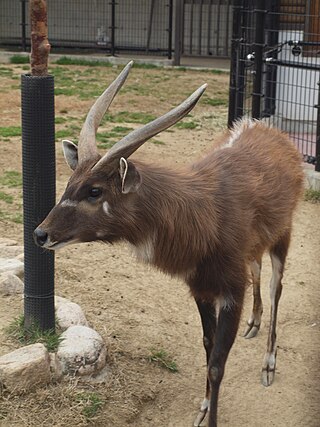
The sitatunga or marshbuck is a swamp-dwelling medium-sized antelope found throughout central Africa, centering on the Democratic Republic of the Congo, the Republic of the Congo, Cameroon, parts of Southern Sudan, Equatorial Guinea, Burundi, Ghana, Botswana, Rwanda, Zambia, Gabon, the Central African Republic, Tanzania, Uganda and Kenya. The sitatunga is mostly confined to swampy and marshy habitats. Here they occur in tall and dense vegetation as well as seasonal swamps, marshy clearings in forests, riparian thickets and mangrove swamps.
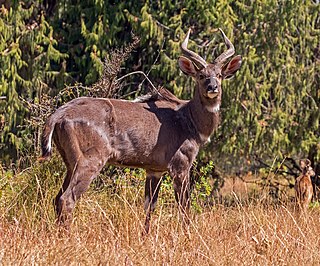
The mountain nyala or balbok, is a large antelope found in high altitude woodlands in a small part of central Ethiopia. It is a monotypic species first described by English naturalist Richard Lydekker in 1910. The males are typically 120–135 cm (47–53 in) tall while females stand 90–100 cm (35–39 in) at the shoulder. Males weigh 180–300 kg (400–660 lb) and females weigh 150–200 kg (330–440 lb). The coat is grey to brown, marked with two to five poorly defined white strips extending from the back to the underside, and a row of six to ten white spots. White markings are present on the face, throat and legs as well. Males have a short dark erect crest, about 10 cm (3.9 in) high, running along the middle of the back. Only males possess horns.

The lesser kudu is a medium-sized bushland antelope found in East Africa. The species is a part of the ungulate genus Tragelaphus, along with several other related species of striped, spiral-horned African bovids, including the related greater kudu, the bongo, bushbuck, common and giant elands, nyala and sitatunga. It was first scientifically described by English zoologist Edward Blyth (1869).

The greater kudu is a large woodland antelope, found throughout eastern and southern Africa. Despite occupying such widespread territory, they are sparsely populated in most areas due to declining habitat, deforestation, and poaching. The greater kudu is one of two species commonly known as kudu, the other being the lesser kudu, T. imberbis.

The common eland, also known as the southern eland or eland antelope, is a large-sized savannah and plains antelope found in East and Southern Africa. It is a species of the family Bovidae and genus Taurotragus. An adult male is around 1.6 m (5.2 ft) tall at the shoulder and can weigh up to 942 kg (2,077 lb) with a typical range of 500–600 kg (1,100–1,300 lb), 340–445 kg (750–981 lb) for females). It is the second-largest antelope in the world, being slightly smaller on average than the giant eland. It was scientifically described by Peter Simon Pallas in 1766.

The giant eland, also known as the Lord Derby's eland and greater eland, is an open-forest and savanna antelope. A species of the family Bovidae and genus Taurotragus, it was described in 1847 by John Edward Gray. The giant eland is the largest species of antelope, with a body length ranging from 220–290 cm (87–114 in). There are two subspecies: T. d. derbianus and T. d. gigas.

The red-flanked duiker is a species of small antelope found in western and central Africa in countries as far apart as Senegal and Sudan. Red-flanked duikers grow to almost 15 in (38 cm) in height and weigh up to 31 lb (14 kg). They have russet coats, with greyish-black legs and backs, and white underbellies. They feed on leaves, fallen fruits, seeds and flowers, and sometimes twigs and shoots. The adults are territorial, living in savannah and lightly wooded habitats, and the females usually produce a single offspring each year. They have lifespans of ten to fifteen years in captivity.

Taurotragus is a genus of large antelopes of the African savanna, commonly known as elands. It contains two species: the common eland T. oryx and the giant eland T. derbianus.

The tribe Tragelaphini, or the spiral-horned antelopes, are bovines that are endemic to sub-Saharan Africa. These include the bushbucks, kudus, and the elands. The scientific name is in reference to the mythical creature the tragelaph, a Chimera with the body of a stag and the head of a goat. They are medium-to-large, tall, long-legged antelopes characterized by their iconic twisted horns and striking pelage coloration patterns.
Elaeophora sagitta is a parasitic nematode found in the heart, coronary arteries and pulmonary arteries of several ruminant species and African buffaloes in Africa. Infestation usually occurs without significant health effects in the Greater kudu, but may affect cardiac function in some other host species.

The northern bushbuck or harnessed bushbuck, is a medium-sized antelope, widespread in sub-Saharan-Africa. The northern bushbuck species has been separated from the Cape bushbuck, a southern and eastern species.

The Albany thickets is an ecoregion of dense woodland in southern South Africa, which is concentrated around the Albany region of the Eastern Cape.

The Mongalla gazelle is a species of gazelle found in the floodplain and savanna of South Sudan. It was first described by British zoologist Walter Rothschild in 1903. The taxonomic status of the Mongalla gazelle is widely disputed. While some authorities consider it a full-fledged monotypic species in the genus Eudorcas, it is often considered a subspecies of Thomson's gazelle, while other authorities regard it as subspecies of the red-fronted gazelle.
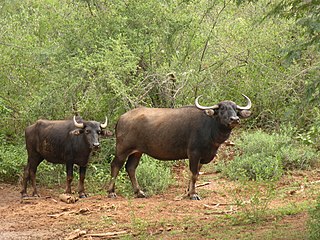
Bubalina is a subtribe of wild cattle that includes the various species of true buffalo. Species include the African buffalo, the anoas, and the wild water buffalo. Buffaloes can be found naturally in sub-Saharan Africa, South Asia and Southeast Asia, and domestic and feral populations have been introduced to Europe, the Americas, and Australia. In addition to the living species, bubalinans have an extensive fossil record where remains have been found in much of Afro-Eurasia.
